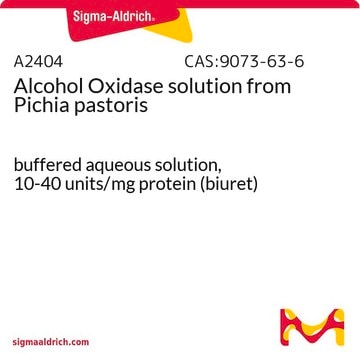推薦產品
應用
D-fructose dehydrogenase is used as a biosensor to detect the presence of D-fructose.
Fructose dehydrogenase (FDH) is used in a number of basic research projects to examine the electrochemical properties of enzyme-catalyzed electrode reactions called bioelectrocatalysis. D-fructose dehydrogenase has been used in a study that contributed towards a convenient method for measuring rare sugars, monosaccharides, for applications in the bio-industry. A direct electron transfer reaction of d-fructose dehydrogenase adsorbed on a porous carbon electrode surface has been used to describe a batch-type coulometric d-fructose biosensor.
生化/生理作用
D-fructose dehydrogenase catalyzes the oxidation of D-fructose to 5-keto-D-fructose.
Fructose dehydrogenase (FDH) is a heterotrimeric membrane-bound enzyme commonly seen in various Gluconobacter sp. especially in Gluconobacter japonicus (Gluconobacter industrius). It has a molecular mass of ca. 140 kDa, consisting of subunits I (67kDa), II (51 kDa), and III (20 kDa) and catalyzes the oxidation of D-fructose to produce 5-keto-D-fructose. The enzyme is a flavoprotein-cytochrome c complex with subunits I and II covalently bound to flavin adenine dinucleotide (FAD) and heme C as prosthetic groups, respectively.
單位定義
One unit will convert 1.0 μmole D-fructose to 5-ketofructose per min at pH 4.5 at 37 °C.
外觀
Lyophilized powder containing citrate-phosphate buffer salts, TRITON® X-100, and stabilizer
儲存類別代碼
11 - Combustible Solids
水污染物質分類(WGK)
WGK 3
閃點(°F)
Not applicable
閃點(°C)
Not applicable
個人防護裝備
Eyeshields, Gloves, type N95 (US)
分析證明 (COA)
輸入產品批次/批號來搜索 分析證明 (COA)。在產品’s標籤上找到批次和批號,寫有 ‘Lot’或‘Batch’.。
Seiya Tsujimura et al.
Analytical chemistry, 81(22), 9383-9387 (2009-11-17)
This paper describes a batch-type coulometric d-fructose biosensor based on direct electron transfer reaction of d-fructose dehydrogenase (FDH) adsorbed on a porous carbon electrode surface. The adsorbed-FDH electrodes catalyzed the electrochemical two-electron oxidation of d-fructose to 5-keto-d-fructose without a mediator.
Ana Dominguez et al.
Revista iberoamericana de micologia, 23(3), 189-191 (2007-01-02)
Several microorganisms are reported to have transfructosylation activity due to fructosyltransferase and/or fructofuranosidase activities. However, the search for other fungi with higher transfructosylation activity remains a challenge. So, a presumptive and indirect colorimetric plate assay for the evaluation of transfructosylation
Takeo Miyake et al.
Journal of the American Chemical Society, 133(13), 5129-5134 (2011-03-12)
Nanostructured carbons have been widely used for fabricating enzyme-modified electrodes due to their large specific surface area. However, because they are random aggregates of particular or tubular nanocarbons, the postmodification of enzymes to their intrananospace is generally hard to control.
Amperometric flow injection determination of fructose with an immobilized fructose 5-dehydrogenase reactor.
K Matsumoto et al.
Analytical chemistry, 58(13), 2732-2734 (1986-11-01)
S Kadow et al.
Biotechnology and bioengineering, 91(2), 154-161 (2005-05-26)
A biosensor for fructose determination was used as basis of an assay for the determination of glucosyltransferase (GTF) activities and applied to monitoring recombinant enzyme production. GTFs catalyze the synthesis of glucans from sucrose leading to the release of fructose.
我們的科學家團隊在所有研究領域都有豐富的經驗,包括生命科學、材料科學、化學合成、色譜、分析等.
聯絡技術服務






